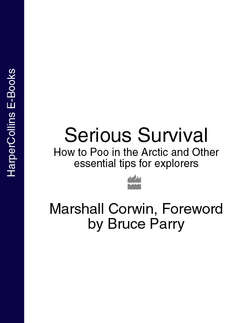Читать книгу Serious Survival: How to Poo in the Arctic and Other essential tips for explorers - Bruce Parry - Страница 21
ОглавлениеTents and Igloos
After a hard day on the ice at –40°C (–40°F) with an Arctic gale blowing, there’s nothing quite like the thought of getting back inside your tent. The only slight problem is that if you’re on the move you’ll first have to put it up. And don’t imagine your sleeping tent is going to be warm and toasty like a room back home. If you’re lucky it might be no colder than a freezer.
Choose a tent designed to withstand Arctic storms, and before the expedition begins practise putting it up quickly with thick mitts on. You might have to do it for real in atrocious weather.
The polar pyramid tents below, used in Serious Arctic, are large enough to allow some cooking.
Flaps at ground level round the tent are piled up with snow to help anchor it in the wind.
Guy ropes are secured with ice screws on the frozen sea (which is covered here in a layer of snow). On deep snow away from the sea they may be attached to a buried ski pole or other improvised anchor (known as a ‘deadman’). A top tip is to pee in the snow above the ‘deadman’ – as the wee freezes it helps make it more secure.
STOVES
Using stoves in small tents can be very dangerous (one for the experts only), so all melting of snow and cooking will probably be done in a larger, main expedition tent. The goods news is that as a result this tent may get pretty warm in the evening. But fuel is precious and likely to be in short supply. This means once supper is over the stoves will go off for the night and the temperature will plummet.
Note that whenever stoves are on there is serious risk of fire – and carbon monoxide poisoning. Although it may go against the grain when it’s so cold outside, it’s absolutely vital to ensure there is enough ventilation.
